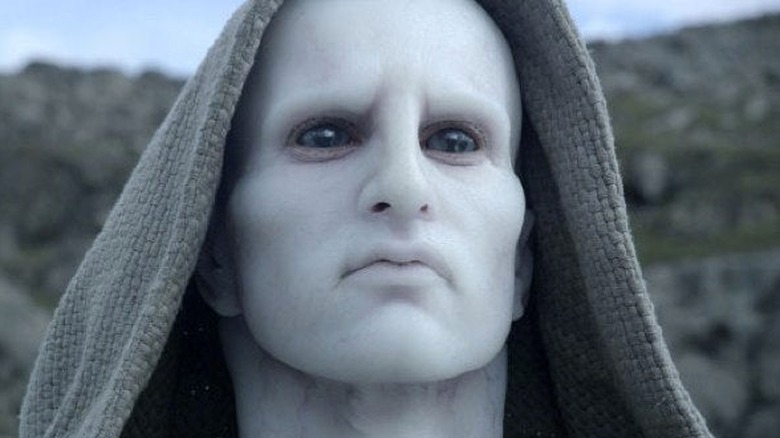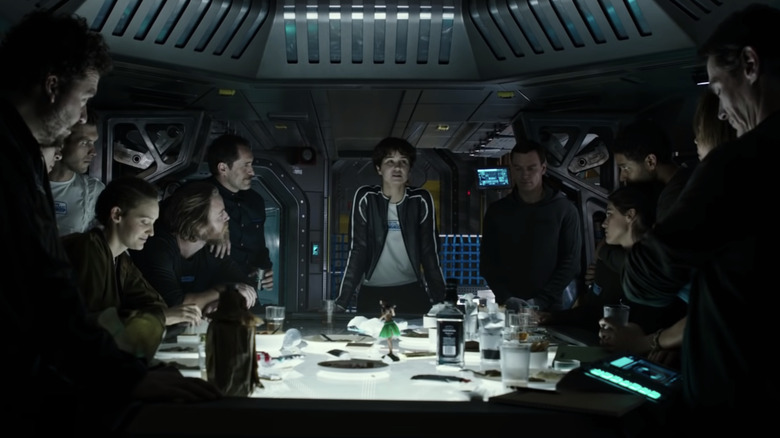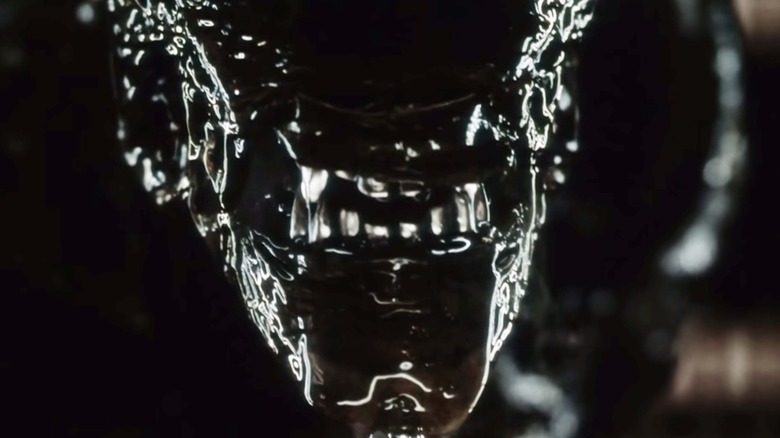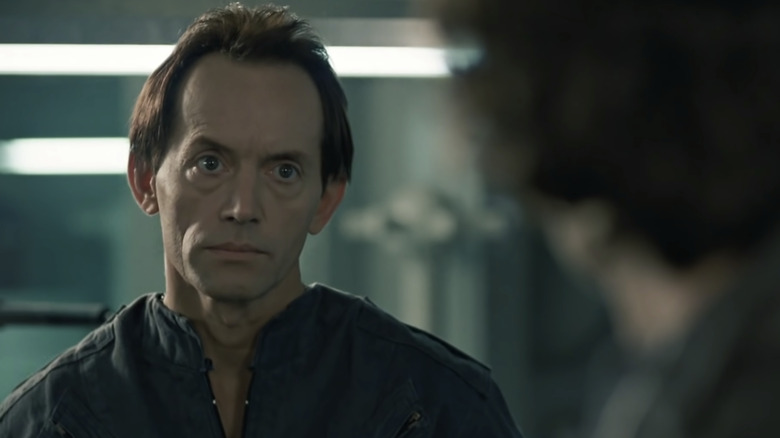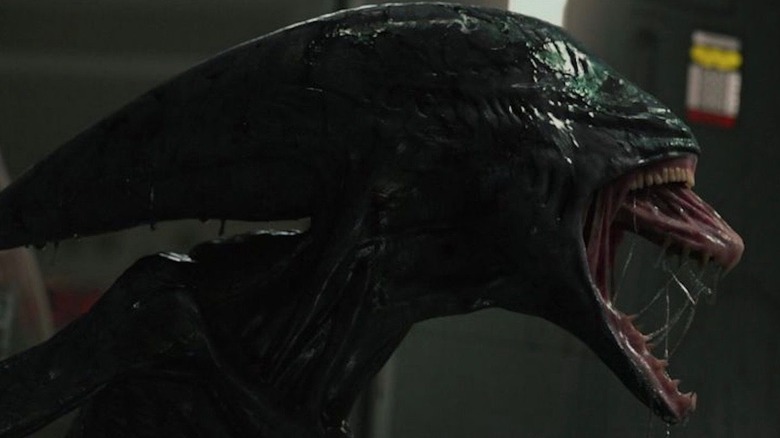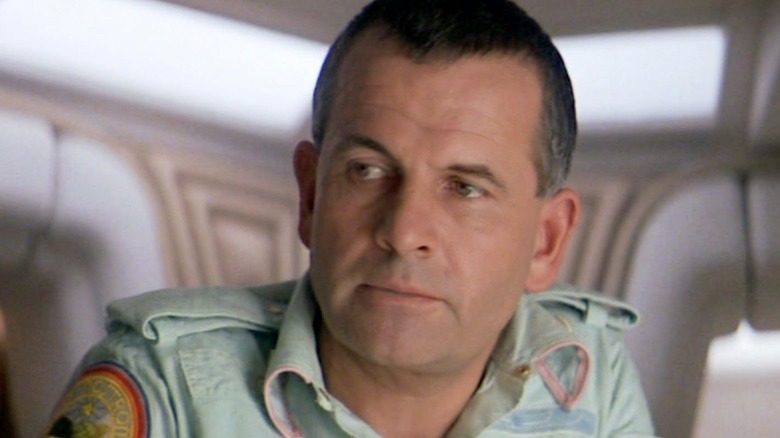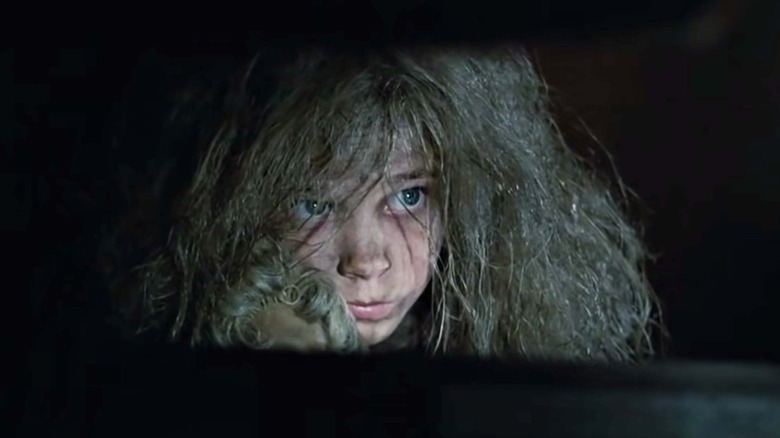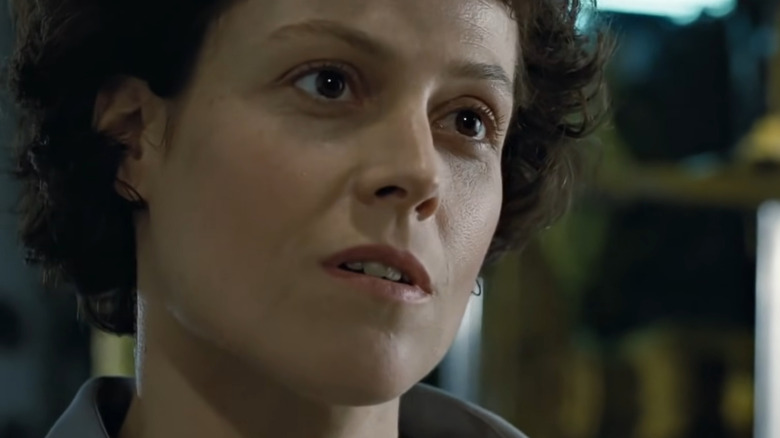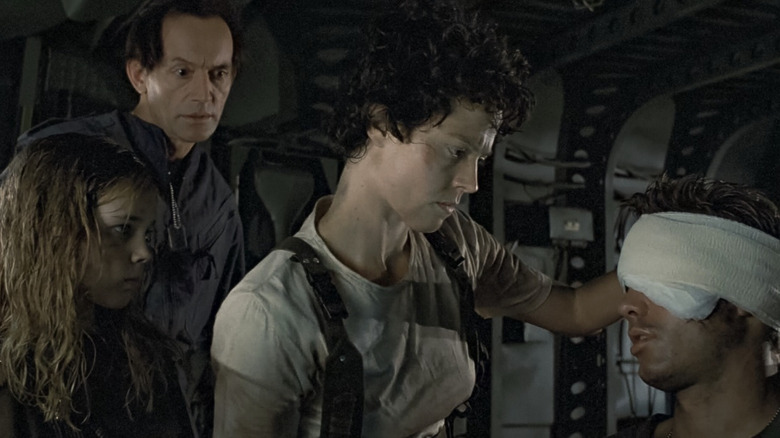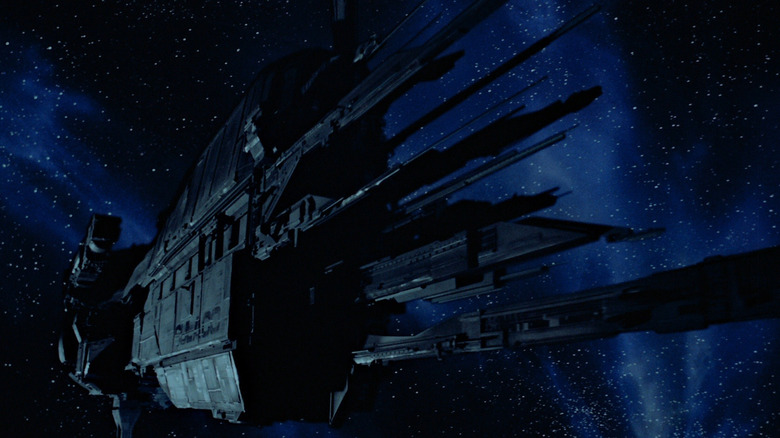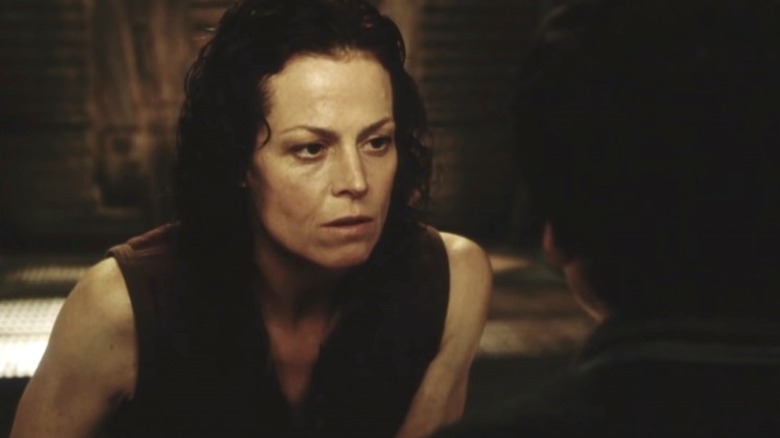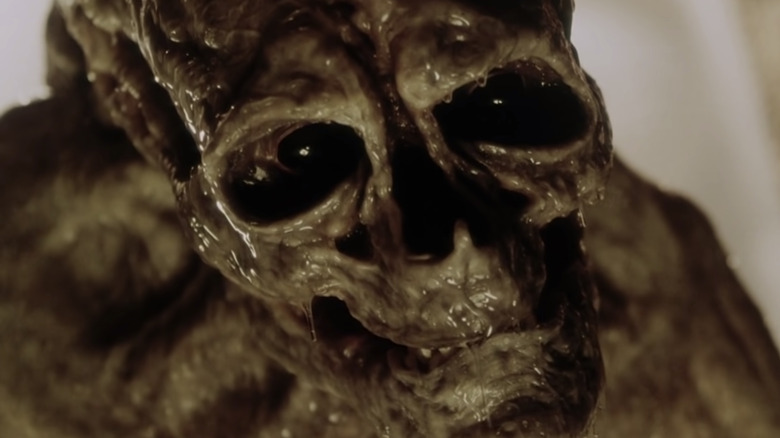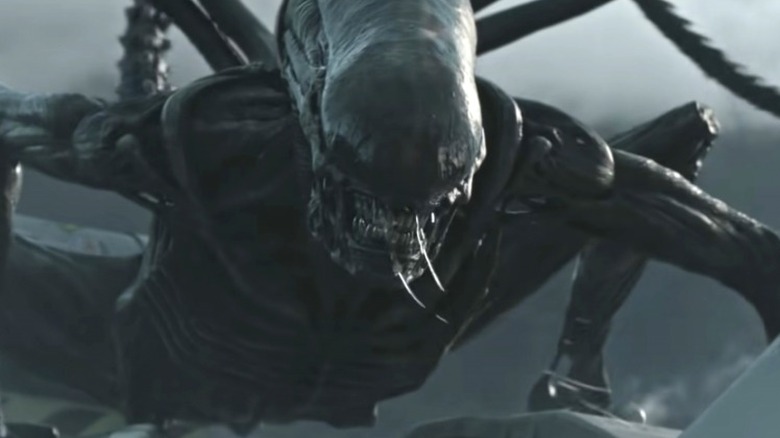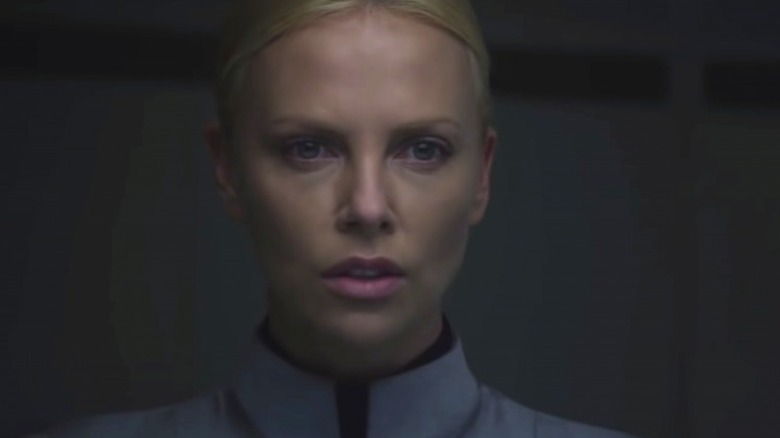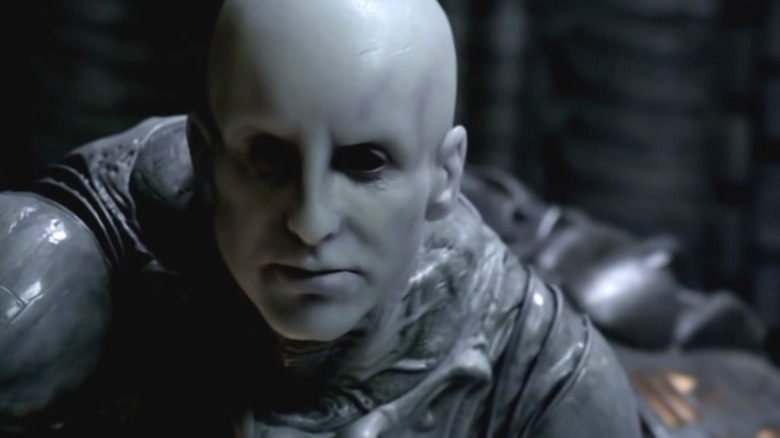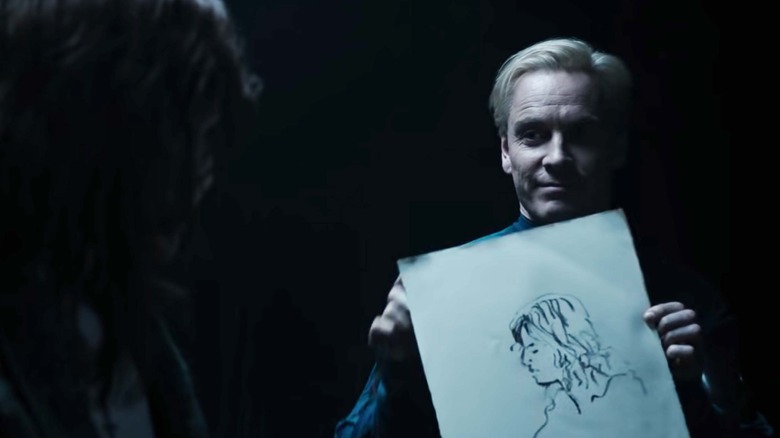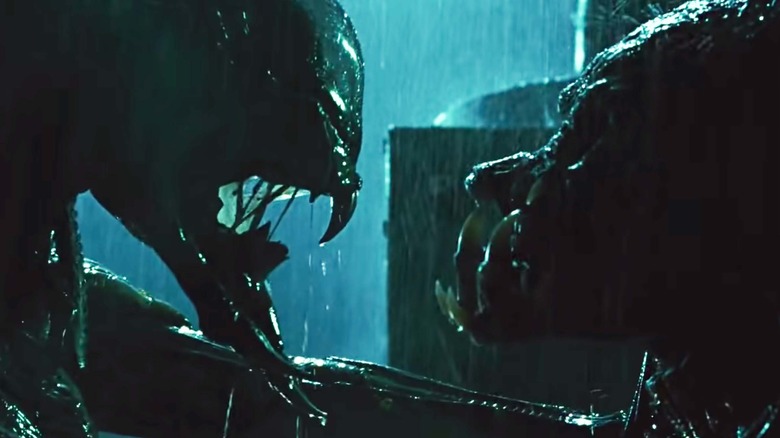The Most Confusing Moments In The Alien Movie Franchise Explained
Since the debut of the original Ridley Scott film in 1979, the "Alien" franchise has been a staple in the world of science-fiction and horror. Though the series took a turn from straight-up horror into the action genre following James Cameron's follow-up, "Aliens" — not unlike what he'd do with the "Terminator" franchise in the early '90s — this sci-fi giant has remained on top of the genre since its inception, no matter how many bad sequels are made.
While the trademark Xenomorph is the most recognizable face of the "Alien" anthology, Sigourney Weaver's Ellen Ripley is a very close second. Since her first appearance in "Alien" — considered one of the best sc-fi movies of all time — Ripley has been surviving close encounters like no other, sparking a wave of female action heroes long before Katniss Everdeen was dreamt of. It's no wonder that, even without Weaver in the leading role, the franchise has continued to expand ever since, spawning crossovers and prequels that only further develop the face-hugger-infested world.
Hopefully, we can help you better understand the Xenomorph's metamorphosis. Or, at least how everything fits into place in the sometimes confusing world of the "Alien" franchise.
Wait, when are these movies set?
The "Alien" franchise doesn't (usually) take place in the present, or even on Earth. Instead, the original "Alien" takes place in the year 2122. The USS Nostromo crew lives in a universe where the Earth is dying due to human interference, hence the Weyland-Yutani Corporation's desire to "build better worlds." Its sequel, "Aliens," is set over 50 years later in 2179 after Ripley wakes up from her accidentally-extended cryosleep. The immediate follow-up, 1992's "Alien 3," is set almost immediately afterward.
This is where the timeline begins to get a bit tricky. Though the next installment of the original anthology, "Alien: Resurrection," takes place over 200 years post "Alien 3" in 2381 A.D., the series ends there, following a clone of Ripley rather than the real deal. From there, Scott's controversial prequel films, "Prometheus" and "Alien: Covenant," take place primarily in the years 2093 and 2104, respectively, just a few decades before the original "Alien."
Between the original anthology and prequels, two crossover films were released that blended "Aliens" with the "Predator" movies. "AVP: Aliens vs. Predator" was released in 2004 and the film takes place that same year, establishing the origins of the Xenomorph in the 21st century. Well, older actually, but that's another discussion. Its follow-up, "Aliens vs. Predator: Requiem," was released in 2007, though it takes place immediately following the first "AVP." Needless to say, the "Alien" timeline is all over the place.
Xenomorph variants
Throughout the franchise, we see a handful of different alien creatures. From the original eggs and their face-hugging offspring to the Chestbursters that grow into full-on Xenomorphs, the life cycle of an alien is a fascinating thing. But, as it turns out, there are plenty of other alien variants out there, and some of them are a bit deadlier than the original classic — even if the first "Alien" is the most iconic.
In "Alien 3," a Facehugger impregnates a dog with its extra-terrestrial spawn, resulting in a four-legged Xenomorph called a Runner. These creatures are a bit more primal than the traditional two-legged Xenomorph, presumably because they derive from a canine instead of a homo-sapien. As a result, it hunts the prisoners of Fiorina 161 before Ripley and her new companions are able to put it down. This becomes a recurring trend throughout the "Alien" sequels as new variants of the iconic Xenomorph begin to develop.
By the time "Alien: Covenant" rolls around, it's explained that many of these variations are due to genetic manipulation by the android David (Michael Fassbender), who may be the one responsible for creating the aliens in the first place. By mixing a black liquid mutagen with different hosts and gene pools, be they humanoid or otherwise, David creates the genetic template for what would become known as the Xenomorph. From there, the "Alien" franchise is born, and the horror continues.
All the Bishops
One of the most welcomed changes made by Cameron in the hit sequel "Aliens" is the inclusion of the android Bishop. Played by legendary "Millennium" and "The Terminator" star, Lance Henriksen, Bishop proves himself to be something of a hero throughout the film, subverting Ripley's expectations after her previous encounters with synthetics. Thus, Bishop aids Ripley, Corporal Hicks (Michael Biehn), and Newt (Carrie Henn) in their escape as they leave the alien threat forever. Well, not really, but that's the hope.
Though not everyone makes it to "Alien 3" alive (more on that later), Bishop survives to help Ripley one final time before being deactivated for good — though another Bishop soon takes his place. However, this version — designated "Bishop II" in the credits — isn't the heroic android from "Aliens," instead arriving on the behalf of Weyland-Yutani to take Ripley and her alien spawn. To this day, it's unclear if Michael Bishop is human or another android, but according to Henriksen, "they were leaving that open because they weren't sure what they were going to do with [the character]" (via IGN).
Though, there is at least one human Bishop out there. In the original "AVP: Aliens vs. Predator," Henriksen returns as a human being named Charles Bishop Weyland, one of the original founders of Weyland-Yutani back in the 21st century. Unfortunately, this Bishop is undoubtedly flesh-and-blood and is eventually ripped apart by a Predator. Apparently, Bishops can never seem to catch a break.
How does the Xenomorph grow so fast?
In the first "Alien," USS Nostromo crew member Kane (John Hurt) is infected by a Facehugger while exploring a downed spacecraft on the moon of LV-426. Immediately following his exposure, he's taken back aboard the Nostromo — ignoring Ripley's very logical quarantine protocols — and operated on by the android Ash (Ian Holm). Eventually, the Facehugger leaves Kane and dies, and Kane wakes up, seemingly back to normal. Except, nothing would ever be normal again.
Later, a Chestburster claws its way through Kane's chest in a gruesome scene that most folks didn't see coming. It's a brutal moment, and as the tiny alien gets away, it only takes a few hours, if that, before it grows into a full-fledged Xenomorph. But how does it grow up so fast? While the exact lifespan and life cycle of the titular alien creatures is something of a mystery, we do know that immediately upon the Chestbursters "birth," it evades capture in order to hide in a dark corner of the Nostromo, presumably to go through some metamorphosis in peace.
By the time the creature is next seen, its transformation is complete. This adult-sized alien Drone is now capable of killing the entire crew. In reality, the alien's quick transformation might be the catalyst for its murderous rampage as the creature may need nourishment to support its newfound change in appearance. No doubt, Weyland-Yutani would love the chance to study it further.
Ash isn't nearly as sophisticated as other androids
Synthetic androids are another trademark of the "Alien" franchise. No matter the installment — well, aside from "Aliens vs. Predator" — a synthetic manages to rear its human-like head and cause some commotion. Sometimes they're good, sometimes they're bad, but often they're integral to the overall plot and have some sort of hidden agenda. In Scott's "Alien," the android Ash is an A/2 model synthetic that runs the hidden objective of capturing the Xenomorph alive for study at "the Company."
Future sequels, including "Aliens," "Alien: Resurrection," and the prequel, "Alien: Covenant," include a variety of synthetics with different capabilities. Bishop turns out to be something of a hero, Call (Winona Ryder) is more advanced emotionally, and David runs his own personal objectives following "Prometheus," including the re-creation of the Xenomorph as we know it today. Ash, on the other hand, didn't have much of a personality or any personal investment beyond his orders from Weyland-Yutani. More than that, Ash was also defective and, like other synthetics on other ships, prone to malfunction.
This is referenced again in "Aliens" when Bishop explains that "the A2s always were a bit twitchy." Evidently, the bugs in Ash's model were dealt with in future models, further explaining why Bishop and Call could better manage their complex emotions. In fact, Bishop also reveals that the synthetics post-the A2s have been fitted with behavioral inhibitor chips, meaning they shouldn't try to kill you with a magazine.
Why did it take so long for Hadley's Hope to be infected?
Not much occurs between the events of "Alien" and "Aliens," but there was one distinct change made to the supermoon, LV-426, aka the newly minted Acheron: Hadley's Hope. A terraforming colony, Hadley's Hope was built about 36 years after the events of the original film, and still two decades prior to the events of Cameron's sequel. The colony began producing breathable air for humans as Acheron was slowly transformed into a livable planet.
But, given the long-term nature of the terraforming process, Hadley's Hope never completed its original mission, at least not before the alien invasion. After almost 60 years, Weyland-Yutani ordered another investigation of the derelict spacecraft on LV-426, resulting in the hatching of more Facehuggers and the creation of a new warrior breed of Xenomorph by their Queen. But, what doesn't quite add up is why it took so long for the terraforming colony to be infested with aliens.
Plot convenience aside, it's possible that the colonists didn't know anything about the "Space Jockey" crashed spacecraft, despite spending decades on Acheron. If the ship had been previously invisible to the people of Hadley's Hope — as the special edition of the film seems to imply — then the colony would've never disturbed the eggs. As always, they would've been much better off keeping to themselves, and ignoring the company's orders.
Ripley makes a few of the same mistakes
Though "Aliens," like Cameron's other famous sequel, "Terminator 2: Judgment Day," flips the script on the original and introduces us to a more capable Ripley, she's not without her flaws. In fact, she's similar to Sarah Connor in that she manages to forget some of the most important lessons she learned from the first film — which may have contributed to her ultimate end in "Alien 3."
At the end of "Alien," Ripley leaves the Nostromo behind and presumably the Xenomorph with it. But, to Ripley's horror, the titular alien steals away on her shuttle, forcing her to make one final stand. In "Aliens," the Xenomorph Queen attempts something similar, stowing aboard the shuttle to the USS Sulaco. Thankfully, Ripley, once again, blows the alien out of the airlock. While Ripley believes they're safe, she doesn't double-check the ship for other potential threats, which, of course, leads directly to the deaths of Hicks and Newt in "Alien 3."
Ripley makes a few other strange mistakes throughout "Aliens," including using a flamethrower on the alien eggs when they're already about to be nuked from above anyway — which only makes the Queen all the angrier. She also forgets about the Xenomorphs' ability to crawl through air ducts, despite that being how some of her Nostromo buddies were killed last time around. No doubt, Ripley's gone through a lot, but when lives are on the line, you'd think she'd pull it together.
The Newt and Hicks problem
For decades, we've debated over which "Alien" movie is the greatest. Is it Scott's original, or is it Cameron's sequel? While we can't answer that impossible question here, it's clear that David Fincher's "Alien 3" is not the franchise's best. Though Ripley, Hicks, Newt, and Bishop all survive the Acheron invasion at the end of "Aliens," their victory is short-lived as their vessel crashes into the prison world of Fiorina 161 in the third film's opening.
This course correction is caused by a Facehugger, which melted some of the ship's primary systems. Because of this, Hicks and Newt are brutally killed in the crash, and Bishop is left beyond repair, leaving Ripley alone to fight off a new Xenomorph. While she makes some new allies on Fiorina 161, none are as meaningful to her as Hicks and Newt, leaving Ripley broken over the loss of her surrogate family.
But, if you hate the ending to Hicks' story as much as we do, there are a few unproduced drafts of "Alien 3" out there that keep Newt, Hicks, and Bishop in the picture, and the 2013 video game, "Aliens: Colonial Marines," even introduces a parallel history in which Hicks is saved before his death. It's explained that the soldier who died in the threequel was a different Marine accidentally inserted into his pod after Hicks was awakened. While the canonicity of "Colonial Marines" is debatable, it certainly gives Hicks a more heroic send-off.
How does an egg get on the Sulaco?
Speaking of the controversial "Alien 3," one of the most confusing moments is the introduction of the alien egg that ends up on board the USS Sulaco. Of course, we all know that the Facehugger that hatched from this egg is responsible for the deaths of Newt and Hicks, but how did it manage to climb aboard the spacecraft? While there isn't a direct answer to this question in either "Aliens" or "Alien 3," there are a few theories that might shed some light on this apparent plot hole.
The first is that the Alien Queen may have implanted an egg in the ship before being launched out of the airlock. Admittedly, this seems a bit far-fetched given that the Queen's egg-sac was destroyed by Ripley back on Acheron, not to mention the brevity of their final battle. Even if the Queen had laid an egg within the landing gear of the shuttle before revealing itself, it still doesn't explain how the egg got further inside the Sulaco, or anywhere near the cryosleep pods which housed Ripley and the other survivors.
Another explanation could come from the "Aliens: Colonial Marines" video game which explains that another ship sent by Weyland-Yutani intercepted the Sulaco while Ripley and her friends were in cryosleep. It's then that the Weyland-Yutani crew let in a Facehugger from their own craft where they'd been experimenting on Xenomorphs, which leads directly into the events of "Alien 3."
Ripley 8 feels like a completely different character
One of the most hated films in the "Alien" chronology, the final installment of the original series, "Alien: Resurrection" takes the Ripley saga a step further by cloning the forever-survivor. Eventually, the results are Ripley 8, a clone of the original Ripley who died over 200 years prior to the events of "Resurrection." This Ripley is a bit more alien than she might care to admit. Throughout the film, Ripley 8 is shown to be more aggressive, sarcastic, and considerably stronger than the original star of the franchise.
No doubt, Weaver's performance deserves all the praise since she is considerable and by far the best part of "Alien: Resurrection," but as for her shift in personality, there's a good reason for that. Ripley 8 is not the first clone of Ripley to be developed, though she was the most successful. Following Weyland-Yutani's shutdown, Ripley's genetic samples from the Fiorina 161 prison were collected by the United Systems Military, who then produced seven defective Ripley hybrid clones before finding success with Ripley 8.
Due to the change in the original Ripley's DNA during the events of "Alien 3," which included a Queen growing inside her, Ripley 8 was grown from a different genetic template that included Xenomorph DNA. As a result, Ripley 8 received alien attributes as well as human ones, including more aggressive tendencies and superior strength. Despite her strange origins, Ripley 8 is a one-of-a-kind alien warrior.
The alien-human hybrid
In "Alien: Resurrection," the Ripley clones are created for one specific purpose: to finally breed a perfect alien Queen. This would allow the United Systems Military the genetic material necessary to breed Xenomorphs that they could then weaponize into command-responding soldiers. While this doesn't go as planned for the crew of the USM Auriga, who all die by the film's end, the program itself succeeds in producing the first living alien-human hybrids.
Of course, Ripley 8 is counted among them, given her shared alien DNA and connection to the hivemind, as well as the cloned alien Queen itself. In fact, by the end of the film, the Queen births a creature called a Newborn that even has human features. A perfect alien-human hybrid, the Newborn kills its alien mother before bonding with Ripley 8 in one of the strangest scenes in the entire franchise. As it turns out, the Newborn sees the cloned Ripley as its true mother due to their shared DNA, and thus kills the Queen to protect her.
Sadly, the Newborn quickly proves itself a threat to humanity and synthetics alike, just like its other alien siblings. In the climax of "Resurrection," Ripley 8 is forced to kill the Newborn "Ripley-style" by sending it out into deep space. All the Ripley clone can do is shed a tear for the tortured creature, which is admittedly more than any of us can do. More tragically, this is the last we ever see of Ripley.
Are the prequels actually prequels?
After "Alien: Resurrection," the "Alien" franchise shifted into its "Aliens vs. Predator" phase, with plans for a fifth film stalling out into the ether. That is until Scott returned with his 2012 prequel "Prometheus." This was the first of two Scott-helmed prequel pictures that take place decades before the events of his original "Alien," but despite the obvious connections, "Prometheus" didn't commit to being a prequel and featured some inconsistencies that make us wonder if it isn't a sort of prequel-boot instead, not unlike the recent "Planet of the Apes" trilogy.
The planet visited in "Alien" and "Aliens" is designated LV-426 and features the derelict spacecraft that houses the alien eggs, but "Prometheus" takes place on a more breathable world that seems to be a different moon, this one called LV-223. Likewise, the downed craft seen in "Prometheus" doesn't house any alien eggs, instead containing plenty of black goo. Another change is that the "Space Jockey" in "Alien" is clearly fossilized, while the dead Engineer seen in "Prometheus" isn't even killed in the cockpit.
There are even moments in "Alien: Covenant" that seem to contradict Cameron's "Aliens," including the idea that massive hordes of Xenomorphs could be created biologically without the use of a Queen; and let's not get started on how much more advanced the world of "Prometheus" and "Alien: Covenant" looks compared to the other movies. But hey, maybe Scott's just working on building something completely new, just like David.
Meredith Vickers, human or a machine
One of the biggest mysteries in the "Alien" franchise comes from Scott's prequel "Prometheus," which features a group of explorers as they search for the origins of life in the universe. During their mission, one of the explorers, a woman named Meredith Vickers (Charlize Theron), is revealed to be the daughter of Weyland-Yutani founder, Peter Weyland (Guy Pearce). But, given her often robotic nature, the question of her humanity has been asked time and again — including in the film itself.
That's right, Janek (Idris Elba) actually jokes about Vickers being a robot, which she laughs off before inviting him to her room. Of course, Vickers never bleeds during the film and since she's crushed by the Engineer's Juggernaut craft, we never learn what color it may have been. Vickers also doesn't seem to care when her father is killed — a father who David also calls "father," meaning there's some potential that Vickers may also be a synthetic android rather than flesh-and-blood offspring.
While the film leaves this question unresolved, it was addressed by screenwriter Damon Lindelof when he revealed that "she is not [a robot]." Despite the fact that Vickers and David share a similar appearance and "father," Lindelof claims that this was Peter Weyland's way of creating the son he never had. "What better way to p*** off your daughter than to build the male equivalent of her?" he said (via MTV). Guess that answers that.
Everything about the Engineers
"Prometheus" also introduces the concept that all known life, including human beings, was created by a master race known as the Engineers. The film dives quickly into the philosophical implications of such a discovery as the Prometheus crew follows the star map that leads them to LV-223. But that's when things get a bit confusing. On this moon, the crew learns that the Engineers, or at least the one they encounter, hope to wipe out humanity by releasing the black liquid substance on the planet. Thankfully, Elizabeth Shaw (Noomi Rapace) and her companions are able to prevent this, though not without casualties.
As for why the Engineers turned on their creation, the truth is that we don't know. It's possible that they were frustrated with the constant war and violence among humans, or that they wanted to use the black goo to reinvent the wheel and make a new world from the ashes. Either way, "Prometheus" never explains their frustrations, and its sequel "Alien: Covenant" doesn't do this plotline any favors either.
We also don't learn how the Engineers' civilization fell before the events of "Prometheus." Though we see ruins and an abandoned facility, we don't know much more than that. While we never get a direct answer, "Alien: Covenant" gives us some clues that, possibly, the Engineers on LV-223 destroyed themselves with their own creations, as seen by how easily their race falls when David uses their black substance against them.
David and Shaw's mission
At the end of "Prometheus," David and Shaw embark on a new journey to take the fight to the Engineers and discover why they want to wipe out Earth and all of humanity. With a hopeful ending, it seems like these two companions could headline an entire trilogy and tell a new and interesting story in the "Alien" world, one not completely revolving around a Xenomorph. Well, when Scott's follow-up "Alien: Covenant" was released, all those hopes and dreams died.
For one thing, David has been on his own for a decade and explains that Shaw died years prior. Of course, what David fails to mention is that he killed the entire Engineer population on Planet 4, which Shaw opposed, calling it genocide. Because she turned on him, David used Shaw as an incubator for his biological experiments both before and after she died. Ultimately, he created a proto-Xenomorph that would serve as the ultimate terror of the film.
While we don't see much of Shaw in "Covenant," Scott's short film "The Crossing" takes place in the time between prequels, explaining how Shaw cared for David and rebuilt his body before he betrayed her. Although Shaw never sees her mission realized, David's endgame is only beginning as the android strives to create the perfect monster, going so far as to betray his android brother Walter and his companion, Daniels (Katherine Waterston). With more questions than answers, we can only hope for another sequel.
The canonicity of the Aliens vs. Predator films
The overall "Alien" canon, like other big sci-fi franchises, is always up for debate. Though "AVP: Aliens vs. Predator" and "Aliens vs Predator: Requiem" came out long before Scott's prequels, they were quickly retconned by Fox following the release of "Prometheus." While other "Predator" installments reference the "Alien" franchise — such as "Predator 2" and even 2018's "The Predator" — the world of the Xenomorphs rarely reciprocates.
No doubt, it's exciting to connect these powerhouse franchises, but given the glaring plot holes, the "AVP" movies no longer integrate into the "Alien" canon. One such plot hole is the revelation that the Xenomorphs have been on Earth for centuries and are locked in eternal combat with the Predators. Beyond that, "AVP'" Weyland-Yutani co-founder, Charles Bishop Weyland, contradicts the reveal of Peter Weyland from "Prometheus," as does the hyper-quick development of Xenomorphs from their human hosts to fully-grown aliens in a matter of minutes. Though, the Xenomorph and Predator battle sequences are pretty spectacular.
Ultimately, the best way to understand the "AVP" films is as their own separate continuity. Ironically, "Aliens" director Cameron prefers the first "AVP," explaining that "...of the 4 'Alien' films, [he'd] rate it 3rd" (via Ain't It Cool). Of course, this was before "Prometheus" and "Alien: Covenant," but that's still high praise coming from Cameron. While the "AVP" fit in nicely with the "Predator" franchise, they don't quite work in the newly expanded world of "Alien."
